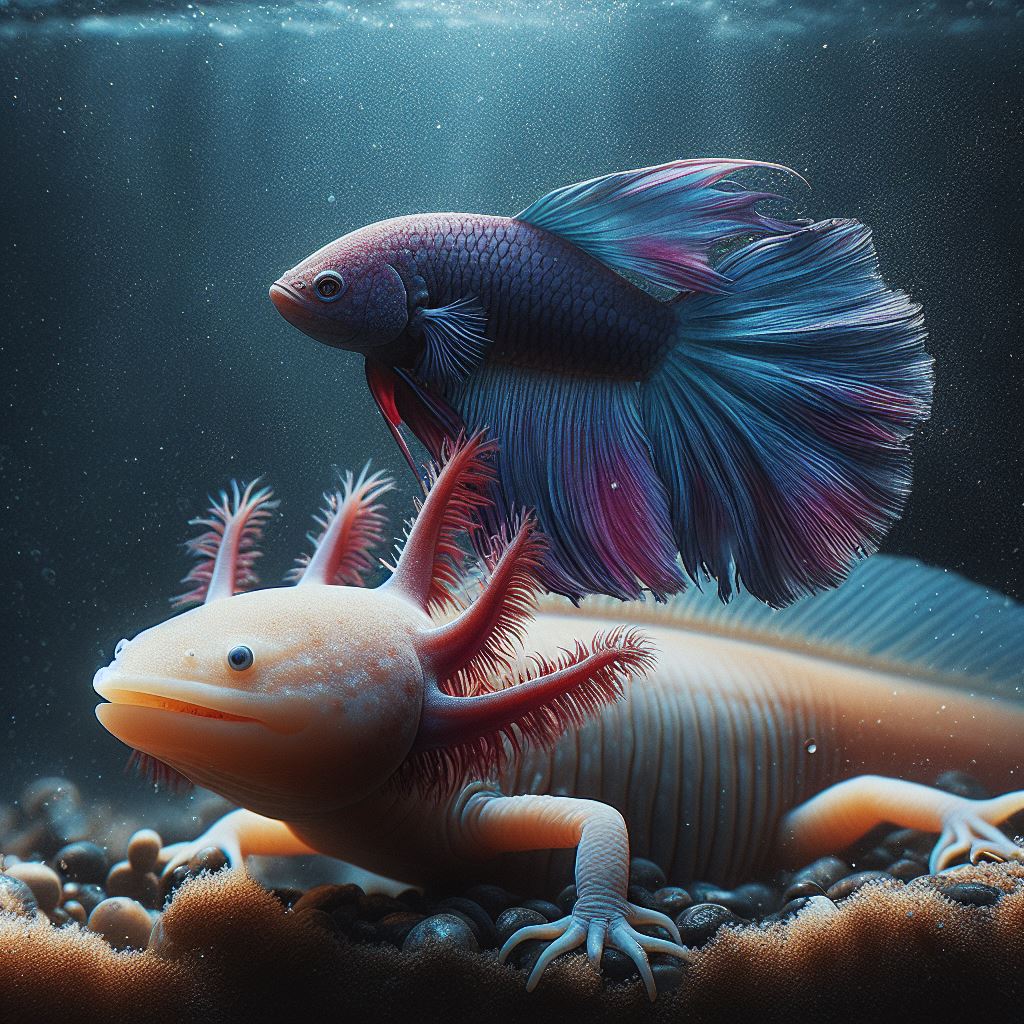
Whether axolotls can coexist peacefully with betta fish is a common query among aquatic enthusiasts. While it’s theoretically possible to house these two species together, it’s not typically recommended due to significant differences in their habitat preferences, behavior, and dietary needs. Axolotls are amphibians native to freshwater habitats in Mexico and prefer cooler temperatures with low flow, while betta fish are tropical fish originating from Southeast Asia, thriving in warmer waters with gentle filtration. Additionally, betta fish are known for their territorial and sometimes aggressive behavior, especially towards other colorful fish with flowing fins, which could potentially stress or harm the axolotls.
Moreover, axolotls have been observed to view smaller fish like bettas as prey, posing a risk to the safety of the fish. Therefore, careful consideration and extensive research into the specific requirements and compatibility of both species should be undertaken before attempting to house them together in an aquarium.
Habitat Requirements: Axolotls vs. Betta Fish
Axolotls and betta fish hail from distinct natural habitats, each with its own set of unique requirements. Axolotls, fascinating creatures native to the ancient waterways of Mexico, thrive in freshwater environments characterized by cool temperatures and ample hiding spots. These neotenic amphibians, famous for their regenerative abilities, prefer temperatures between 16 to 18°C (60 to 64°F), which mimics the cool waters of their native lakes and canals. On the other hand, betta fish originate from the warm, densely vegetated waters of Southeast Asia, favoring temperatures between 24 to 27°C (75 to 80°F). Their natural habitats are often shallow, slow-moving bodies of water with plenty of vegetation and hiding spots. Therefore, while both species share a preference for hiding spots, they differ significantly in their temperature requirements and the type of aquatic environments they thrive in.
Tank Size
Choosing the right tank size is crucial when considering housing axolotls and betta fish together. Axolotls, being relatively large amphibians, require spacious tanks to accommodate their size and swimming habits. A minimum tank size of 20 gallons is recommended for a single axolotl, with an additional 10 gallons per additional axolotl. Betta fish, though smaller in size compared to axolotls, also need adequate space to thrive. A tank size of at least 5 gallons is recommended for a single betta fish, with a larger tank being preferable to promote better water quality and swimming space. When housing these species together, it’s essential to provide a generously sized tank to minimize territorial disputes and ensure each creature has enough space to establish its territory and explore its surroundings comfortably.
Water Parameters
Maintaining appropriate water parameters is vital for the health and well-being of both axolotls and betta fish. Axolotls prefer slightly cooler water with a pH level between 7.4 to 7.6, while betta fish thrive in warmer water with a pH level between 6.5 to 7.5. Additionally, both species are sensitive to ammonia and nitrite levels, which can quickly build up in inadequately filtered tanks. Regular water testing and maintenance are essential to ensure optimal water quality and prevent stress-related illnesses. Providing a suitable filtration system and performing regular water changes are necessary to keep the tank environment stable and conducive to the health of both axolotls and betta fish.
Betta Fish Behavior: How It Affects Axolotls
Understanding betta fish behavior is crucial when considering housing them with axolotls. Bettas, known for their vibrant colors and flowing fins, exhibit various behaviors that can impact the well-being of axolotls. One significant behavior is their territorial nature, especially among males. Male bettas are notorious for their aggression towards other fish, particularly those with similar colors or long fins, which they may perceive as rivals. This territorial behavior can pose a threat to axolotls, especially if they have long external gills or other appendages that resemble fish fins. Additionally, bettas are active swimmers and may inadvertently stress axolotls with their fast movements and flashy displays. Therefore, careful observation and consideration of betta fish behavior are essential when planning to cohabitate them with axolotls.
Aggression Levels
Betta fish are notorious for their territorial and aggressive behavior, especially towards other male bettas and fish with similar appearances. This aggression is primarily driven by the betta’s instinct to establish and defend its territory, particularly in densely planted aquariums or confined spaces. When housed with axolotls, bettas may exhibit aggressive behaviors such as flaring their fins, chasing, or even attacking the axolotls, especially if they perceive them as intruders in their territory. This aggressive behavior can cause stress and potential harm to the axolotls, leading to injuries or even death. Therefore, it’s essential to monitor betta fish closely and provide ample hiding spots and visual barriers to minimize aggressive encounters between them and the axolotls.
Compatibility with Other Species
While betta fish can coexist with certain tank mates, their compatibility with other species, including axolotls, varies depending on individual temperament and tank conditions. In general, bettas are best kept in solitary or species-only tanks to prevent aggression towards other fish. However, under the right conditions, they may tolerate tank mates that are peaceful, non-threatening, and occupy different areas of the aquarium. When considering housing bettas with axolotls, it’s crucial to research the compatibility of both species and provide a spacious tank with plenty of hiding spots and visual barriers to minimize potential conflicts. Additionally, introducing tank mates gradually and monitoring their interactions closely can help prevent aggression and ensure a harmonious cohabitation environment.
Feeding Dynamics
Feeding dynamics play a significant role in the compatibility of betta fish and axolotls in a shared tank environment. Bettas are carnivorous fish that primarily feed on small insects, larvae, and commercial fish flakes or pellets. They are opportunistic feeders and may exhibit aggressive behavior during feeding time, especially if competing for food with other fish. Axolotls, on the other hand, are carnivorous amphibians that primarily feed on live or frozen foods such as bloodworms, earthworms, and small fish. Their feeding behavior is relatively slow-paced compared to bettas, and they may not compete well for food if housed with more aggressive fish species. Therefore, it’s essential to consider the feeding dynamics of both species and provide appropriate food options and feeding strategies to ensure each creature receives an adequate diet without competition or aggression during meal times.
Dietary Differences Between Axolotls and Betta Fish
Axolotls and betta fish have distinct dietary preferences and nutritional requirements due to their evolutionary backgrounds and biological differences. Axolotls are carnivorous amphibians that primarily feed on live or frozen prey, such as bloodworms, earthworms, small fish, and insect larvae. Their diet consists mainly of protein-rich foods to support their growth, development, and regenerative abilities. In contrast, betta fish are carnivorous fish that feed on small insects, larvae, and occasionally plant matter in their natural habitat. They have a higher protein requirement compared to herbivorous fish but may also benefit from a varied diet that includes high-quality fish flakes, pellets, and occasional live or frozen foods. Understanding these dietary differences is essential when planning to house axolotls and betta fish together, as it may require separate feeding strategies to meet the specific nutritional needs of each species.
Feeding Frequency
Feeding frequency is an important consideration when caring for axolotls and betta fish in a shared tank environment. Axolotls are typically fed 2-3 times per week, with adult axolotls requiring fewer feedings than juveniles due to their slower metabolism. Overfeeding can lead to obesity and water quality issues, so it’s essential to provide appropriately sized portions and monitor their body condition closely. Betta fish, on the other hand, are usually fed once or twice a day, with small portions to prevent overeating and digestive problems. Their feeding frequency may vary depending on factors such as age, activity level, and water temperature. When housing axolotls and betta fish together, it’s crucial to establish a feeding schedule that meets the dietary needs of both species while preventing overfeeding and competition for food.
Food Preferences
Axolotls and betta fish have distinct food preferences based on their natural diet and feeding behaviors. Axolotls are opportunistic feeders that primarily rely on their sense of smell and movement to detect and capture prey. They prefer live or frozen foods that mimic their natural diet, such as bloodworms, earthworms, and small fish. Betta fish, on the other hand, are visual hunters that primarily feed on small insects and larvae found in their natural habitat. They are attracted to brightly colored and slow-moving foods, making them more likely to accept commercial fish flakes or pellets as part of their diet. Understanding these food preferences is essential when selecting appropriate foods for axolotls and betta fish and ensuring they receive a balanced diet that meets their nutritional needs.
Nutritional Needs
Meeting the nutritional needs of axolotls and betta fish is essential for their overall health, growth, and well-being. Axolotls require a diet rich in protein to support their growth and regeneration, with live or frozen foods being the preferred option due to their high nutritional value. They also benefit from occasional supplementation with calcium and vitamins to promote bone health and prevent nutrient deficiencies. Betta fish have similar protein requirements but may also benefit from a varied diet that includes high-quality fish flakes, pellets, and occasional live or frozen foods. Providing a balanced diet that meets the specific nutritional needs of both species is crucial for maintaining their health and vitality in a shared tank environment.
Potential Risks of Housing Axolotls and Betta Fish Together
While it’s tempting to create a dynamic aquatic community by housing axolotls and betta fish together, there are several potential risks that need to be carefully considered. One significant risk is the aggressive behavior exhibited by betta fish, particularly towards other fish with similar appearances or long fins. This aggression can lead to stress, injuries, or even death among tank mates, including axolotls. Additionally, the competition for resources such as food, hiding spots, and territory can escalate into conflicts and negatively impact the well-being of both species. Another concern is the potential transmission of diseases between axolotls and betta fish, as both species can carry and spread pathogens that may be harmful to each other. Therefore, it’s essential to weigh these potential risks and take proactive measures to minimize them before attempting to house axolotls and betta fish together.
Aggressive Behavior
One of the primary risks of housing axolotls and betta fish together is the aggressive behavior exhibited by betta fish, particularly males. Male bettas are notorious for their territorial nature and may perceive other fish, including axolotls, as intruders in their territory. This can lead to aggressive displays such as fin flaring, chasing, and even physical attacks, especially if the tank environment is small or lacks adequate hiding spots. Aggressive behavior can cause stress and injuries to both axolotls and betta fish, compromising their overall health and well-being. Therefore, it’s essential to monitor their interactions closely and provide ample hiding spots and visual barriers to minimize aggressive encounters and ensure a harmonious cohabitation environment.
Competition for Resources
Another potential risk of housing axolotls and betta fish together is the competition for resources such as food, hiding spots, and territory. Both species have specific requirements and preferences when it comes to these resources, and competition can escalate into conflicts if not properly managed. For example, betta fish are known to be aggressive feeders and may outcompete axolotls for food during feeding time. Additionally, limited hiding spots or territory can lead to territorial disputes and aggression among tank mates. Therefore, it’s essential to provide ample resources and space to accommodate the needs of both species and minimize competition and potential conflicts.
Disease Transmission
Disease transmission is a significant concern when housing axolotls and betta fish together, as both species can carry and spread pathogens that may be harmful to each other. Common diseases such as fungal infections, bacterial infections, and parasites can easily spread in a shared tank environment, especially if water quality and hygiene are not adequately maintained. Additionally, stress caused by aggressive behavior or competition for resources can weaken the immune system of both axolotls and betta fish, making them more susceptible to infections. Therefore, it’s essential to quarantine new tank mates before introducing them to the main tank and regularly monitor water parameters and tank conditions to prevent disease outbreaks.
Temperature and Water Quality Considerations

Maintaining optimal temperature and water quality is essential for the health and well-being of both axolotls and betta fish when housed together. Axolotls are cold-blooded amphibians that prefer cooler water temperatures ranging from 16 to 18°C (60 to 64°F). On the other hand, betta fish are tropical fish that thrive in warmer water temperatures between 24 to 27°C (75 to 80°F). Therefore, finding a suitable middle ground that meets the needs of both species can be challenging but crucial for their overall health and vitality. Additionally, maintaining excellent water quality through regular water testing, filtration, and water changes is essential to prevent stress-related illnesses and disease outbreaks. Providing a clean and stable tank environment will help ensure the well-being of both axolotls and betta fish and promote a harmonious cohabitation experience.
Optimal Temperature Range
Finding the optimal temperature range for a shared tank housing axolotls and betta fish requires careful consideration and monitoring. While axolotls prefer cooler water temperatures between 16 to 18°C (60 to 64°F), betta fish thrive in warmer water temperatures between 24 to 27°C (75 to 80°F). Therefore, it’s essential to aim for a temperature range that falls within the comfort zones of both species, typically around 20 to 24°C (68 to 75°F). Using a reliable aquarium thermometer and adjusting the heating or cooling system accordingly can help maintain a stable temperature within this range. Additionally, providing thermal gradients within the tank, such as warmer and cooler areas, allows each species to regulate their body temperature according to their preferences, promoting overall comfort and well-being.
pH Levels
Maintaining appropriate pH levels is crucial for creating a suitable tank environment for both axolotls and betta fish. Axolotls prefer slightly alkaline water with a pH level between 7.4 to 7.6, while betta fish can tolerate a slightly wider pH range between 6.5 to 7.5. Therefore, aiming for a neutral pH level around 7.0 is ideal for a shared tank housing both species. Monitoring pH levels regularly using a reliable aquarium pH test kit and making adjustments as needed with pH stabilizers or buffers can help maintain a stable and suitable pH environment for axolotls and betta fish alike.
Filtration Requirements
Providing adequate filtration is essential for maintaining excellent water quality and promoting the health and well-being of both axolotls and betta fish. A reliable filtration system helps remove excess waste, uneaten food, and harmful toxins from the water, preventing ammonia and nitrite buildup that can be detrimental to aquatic life. When selecting a filtration system for a shared tank housing axolotls and betta fish, it’s essential to choose a filtration system that provides both mechanical and biological filtration. Mechanical filtration helps remove solid waste particles, while biological filtration promotes the growth of beneficial bacteria that break down harmful ammonia and nitrite compounds. Additionally, regular water changes and filter maintenance are necessary to ensure optimal filtration performance and water quality in the tank. By providing adequate filtration, you can create a clean and healthy environment for both axolotls and betta fish to thrive in.
FAQs
Q. Can axolotls and betta fish live together peacefully?
A. While it’s possible, it’s not recommended due to potential compatibility issues.
Q. What size tank is suitable for housing axolotls and betta fish together?
A. A large tank with plenty of hiding spots and space is necessary to reduce aggression.
Q. Do axolotls eat betta fish?
A. Axolotls may see betta fish as prey, especially if the fish are small.
Q. How can I minimize aggression between axolotls and betta fish?
A. Providing ample hiding spots and ensuring there’s enough space can help reduce aggression.
Q. Can betta fish stress axolotls?
A. Yes, betta fish’s vibrant colors and fast movements can stress axolotls.
Q. What should I feed axolotls and betta fish if I house them together?
A. Separate feeding is recommended, as their dietary needs differ.
Q. Are there any diseases that axolotls and betta fish can transmit to each other?
A. Yes, both species can carry diseases that may be transmitted if housed together.
Q. What temperature should the tank be for axolotls and betta fish?
A. A temperature around 20-24°C (68-75°F) is suitable for both species.
Q. Do axolotls and betta fish require different water parameters?
A. Axolotls prefer cooler water with low flow, while betta fish prefer slightly warmer water with gentle filtration.
Q. Can I add other tank mates along with axolotls and betta fish?
A. It’s best to avoid adding other species to the tank to minimize potential conflicts and stress.
Conclusion
In conclusion, while the idea of housing axolotls and betta fish together may seem appealing, it’s essential to carefully consider the unique requirements, behaviors, and potential risks associated with each species. Axolotls and betta fish have distinct habitat preferences, dietary needs, and temperature requirements, which can pose challenges when attempting to create a harmonious cohabitation environment. Aggressive behavior, competition for resources, disease transmission, and maintaining optimal temperature and water quality are among the key considerations that need to be addressed to ensure the health and well-being of both species.

Hassan Shah carries over four years of hands-on expertise in caring for axolotls, guided by his cherished companion ‘Little Bruno,’ a thriving axolotl under his attentive care for three years.



